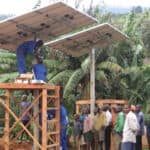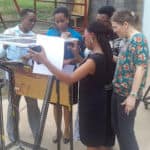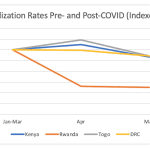Freeing the Data to Build the Off-Grid Energy Sector: A Case Study from Tanzania
Tanzania is a global leader in electricity access, spawning many innovations in systems and business models now commonplace around Africa. There is growing investment in the mini-grid sector across much of the Sub-Saharan Africa region, with systems ranging from solar PV installations in the low kilowatt range, to hydro and biomass systems of multiple megawatts. More recently, standalone solar solutions are filling gaps, with nearly 2 million Lighting Africa-verified products sold to date. At the same time, Tanzania is one of many countries to suffer from high grid connection costs and low access.
Given the current state of electricity access and the dispersed nature of the population, there is room for off-grid energy access solutions to complement the national grid. While mini-grids and solar home systems are already showing promise in many parts of the country, challenges with coordination and information-sharing between government and the private sector create a risk for developers: selecting a site that might become grid-connected before they can recover their investment. Not only can this reduce investor confidence in the sector, it also could prevent off-grid technologies from being used where they are most cost-effective.
Larger international companies have the resources to improve market intelligence, gather data on community locations and compare it with infrastructure maps, all to identify sites that are unlikely to become grid connected in the coming years. Moreover, they have the flexibility to choose from numerous national markets. But smaller local companies typically do not have this level of access. This has created an uneven playing field with grid and off-grid efforts conducted in silos, and a sense that there is little to be gained by sharing data; instead of being seen as a public good, it is viewed as a competitive advantage.
Prioritizing long-term capacity and cross-sectoral value
Our previous research in Tanzania highlighted the importance of two key approaches to improving market intelligence in the off-grid sector: better communication between and within public and private sectors; and supporting the development and transparency of data for unserved populations. The figure below is an example of how a different paradigm can shift attitudes about data and sharing.

An improved sharing model, with data no longer in silos
Many countries and projects have gathered data on household locations and demand indicators, with one frequent problem: The work is done by international consultants without local knowledge, and the data is stored in a way that makes it difficult to update, improve and share. To avoid this, the International Finance Corporation (IFC) team focused on local talent and the creation of highly detailed mapping data with value beyond energy. That data is suitable for OpenStreetMap, the premier open map of the world, which provides an accessible home for this valuable data at no cost to Tanzanian taxpayers.
To achieve this, we contracted the Humanitarian OpenStreetMap Team, an international non-profit organization of mappers dedicated to humanitarian action and community development. We worked with over 100 Tanzanian youths and supervisors to digitize buildings from satellite imagery. They brought local knowledge and understanding of villages and household systems, such as what community centers look like and what constitutes a hamlet. In addition, there is now a well-trained local skill-base in Tanzania, which can help the government and private sector to create improved data, and support similar activities in the region.
We first evaluated Tanzanian villages using existing data sources to focus our efforts on the most critical areas to be mapped. This assessment included factors such as distance from existing grid infrastructure, road accessibility and cellular network coverage. The Tanzanian mapping team then focused on these areas, with individual mappers digitizing up to 1200 buildings per day, totaling over 4 million buildings, in mostly rural areas and from all different regions of the country.
Instead of simply pinpointing each building, the team fully digitized each location. This means that, like many places in more developed countries, many Tanzanian towns and villages now have each building and road carefully outlined, with features like schools identified. Collecting this type of highly-detailed data gives it significantly higher power for predicting demand and determining a village’s suitability for grid or off-grid connections.

OpenStreetMap (L) and Google Maps (R)
This data has huge potential to help energy developers find promising communities, and more easily identify sites that are best served by off-grid systems (or the grid) based on demand and estimated costs. This should improve returns on investment, and more effectively increase access in the country. Beyond this, these new maps are instantly accessible to anyone via the web or mobile phone, and have the potential to be useful to other businesses engaged in these regions. This could make it much easier for markets to find products, and vice versa – not to mention helping health, sanitation and transportation infrastructure needs.
Engaging stakeholders from bottom to top
Nearly 2,000 villages were visited and surveyed with a participatory approach. Using motorbikes for transport and cellphones for surveys, local surveyors were recruited to ensure local understanding and language. Village representatives (and in some cases every household) were interviewed about their access to, and need for, energy. High priority villages and statistical power had to be balanced with logistical considerations and sensible motorbike routes. A simplified extract of the resulting data is shown below. Developers and planners can use this data to get a much better idea of the types of institutional energy that exist, and what kind of demand and growth can be expected from village residents.

Snapshot of mapping and survey data for one village
While the surveying continued, off-grid developers and government planners were brought together in frequent workshops to ensure that this data and the process used were valuable and provided in an accessible manner. This allowed the team to change approaches and incorporate lessons learned over the duration of the project, and ensure that different needs were met. This also highlighted the need for continued engagement with all stakeholders: government, utilities, developers, financial institutions, donors and communities without electricity access.
Emerging indicators for off-grid in Tanzania
Although the primary purpose of this work is to support electrification and the off-grid community in Tanzania, there are several findings that have already emerged from the data. Above all is the great potential for both grid densification and off-grid electrification, in addition to the usual approach of grid extension. The first is indicated by the number of villages in the survey sample with grid access, but a very small number of actual connections ‑ an opportunity for cost-effective connections.
In more remote villages, the calculus is different. Although the government is working towards bringing grid electricity to every village, it remains to be seen how long this will take. With this new data, it is possible to make a systematic comparison of different electrification options for each village. One such comparison is shown below, where 23 villages from around Tanzania were modelled using detailed household data to understand the economics of on- and off-grid connections under different assumptions of demand, coverage and costs.
For smaller villages that are further from the grid (green in the chart), off-grid options offer the potential to bring electricity into homes more cheaply, and more quickly, than grid extension. Larger, near-grid villages would benefit most from grid extension and densification. At least half of the modeled sample is better suited to off-grid connections, but as it stands, they are still awaiting a grid connection of uncertain arrival time. Tanzania has the potential to maintain its position as an innovator and leader in driving electrification, but it needs to take advantage of opportunities in off-grid and densification, supported by grid extension when suitable.

New data allows connections to be modeled in detail with little effort
Open data as a development enabler
The response from government and developers has been very positive, and we are working with both to help them use and improve this resource. Planners can incorporate it into their models, and developers can more quickly find and assess markets, and attract finance. That said, it will require ongoing effort to form the much-needed links between and within these major stakeholders.
The methodology developed here shows considerable value over other methods of data collection, and is already seeing adoption in other countries, such as Zambia and Haiti. Instead of project-specific data that is inaccessible to outsiders, we have contributed to a living database of human activity. We hope to see similar approaches become more widespread in energy and beyond.
Authors’ note: The data produced in this project is already freely available. To explore the first analysis process, please visit the web tool that was created. To download OpenStreetMap building data for the whole of Tanzania, the easiest method is this dataset at HDX. For other data, the HOT Export Tool can be used.
Christopher Arderne is an energy and data specialist with the World Bank Group.
Pepukaye Bardouille is a senior operations officer with the International Finance Corporation (IFC), currently on external service leading Dominica’s newly established Climate Resilience Execution Agency.
Image provided by authors.
- Categories
- Energy, Technology



